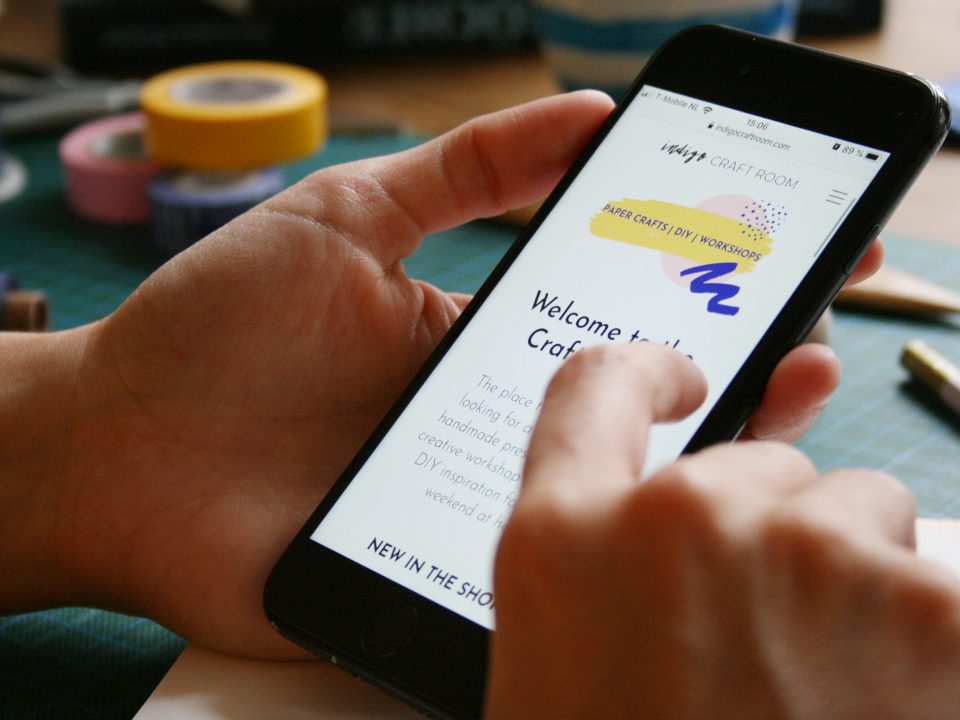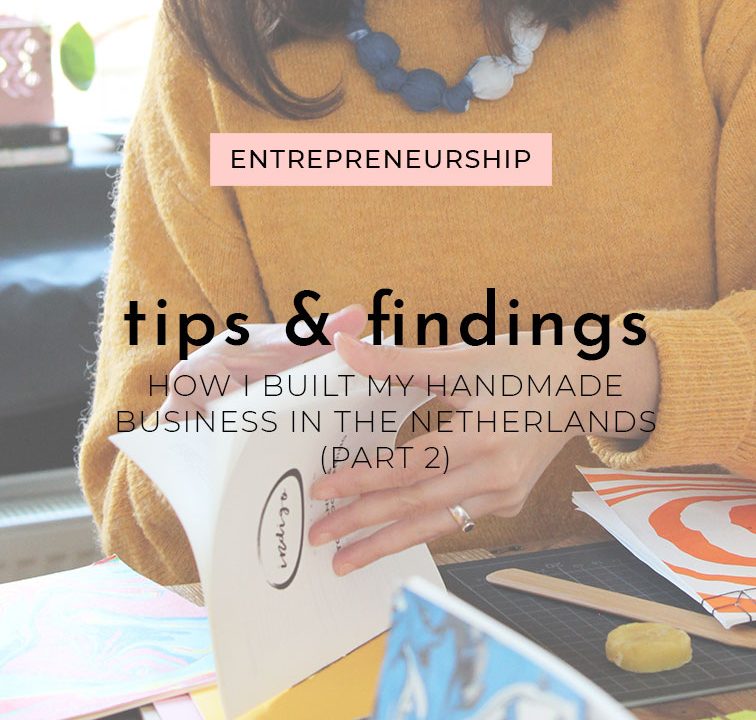
Girlboss 101: The Tools I Use To Run My Handmade Business
12/01/2021
Girlboss 101: Finding The Right Pricing For Your Handmade Business
13/05/2021My previous Girlboss 101 blog post had a big resonance within my community, so I wanted to elaborate in-depth on some of the topics exposed in that first post. Today I want to share how I plan and organize my handmade business, both on paper or digital and in real-life in my bookbinding and paper studio in Munich. Planning and organization are key for any project or business you want to start. Sure, life happens and many times we have to improvise. But having a clear, yet flexible plan and organizational structure will help you to survive even on crazy weeks or over longer periods of time. So, let’s take a look behind the scenes of Indigo Craft Room and see how things are cooked and baked here. Ready?
*** Please take into consideration that the recommendations shared in this post are based on my very own experience and therefore I cannot guarantee any success in your own endeavours. This is not a post with business advice, but merely the story of how I run my own business and the processes and tools that work for me. No affiliate links, all recommendations are based on my own opinion and experience.
-
HOW TO ORGANIZE YOUR WORKING SPACE
I love my bookbinding and paper studio in Munich. Finally, I have a place for myself, which I can decorate and organize the way I want. Before, I used to work from home, where I shared a room or office with my boyfriend. Luckily we had lots of space, but sometimes I felt overwhelmed when his things or his own working routines clashed with mine. Now I just have to take into consideration what works for me and what is possible in the space I have in my studio.
Since I host workshops in the studio, it was important from the beginning that I can re-arrange the set-up easily in order to make more space for participants coming in, when necessary. I also wanted to have two working spaces or desks, so I can switch tasks without too much trouble, e.g. when I’m working on my laptop but at the same time want to shoot some pictures or marble paper.

I had to maximize the space in my studio and so I got some shelves, on which I could arrange my product stock and supplies. I had some small boxes which I painted in my brand colours with Chalk Paint (here is a Chalk Paint tutorial, by the way), and I got some extra baskets which I use to store small books and other tools and supplies. If you are on a budget, you can look for second-hand shops nearby or on the Internet. Plus, you can always upcycle stuff, like cans being reused as a storage container for your craft tools.
- Optimize the space: use high shelves and maximize the space both in horizontal and vertical dimensions
- Your workspace on a budget: upcycle cans, boxes or buy on second-hand shops and online platforms
- If possible, use roller containers to easily re-arrange your space when needed

-
HOW TO ORGANIZE PAPER & DIGITAL DOCUMENTS
At some point in our life, we all find ourselves spending hours looking for a document that we left “somewhere on that pile of stuff”, don’t we? When you run a business, no matter the size, you will be handling lots of important documents every single day. From notifications from your accountant, your insurance, the tax department and of course, your own invoices or project proposals. Nowadays, most documents are created and stored digitally, which can first sound like a dream for both you and the environment. But tell me, how many documents are lying in your downloads folder or desktop without a clue what they actually are and whether they should be saved somewhere? Remember saving your university assignments as “copyoffinalproject-final-final-realfinal”? I do!
Ok, let’s start with the easiest one: the paper documents. If your business is mostly digital you will probably have just some paper documents to store every month: government notifications, some invoice or receipt. I scan all of the documents that are required for my accountancy and store them both in original and digital. If you don’t have a scanner at home, you can use mobile apps like SwiftScan. Depending on how you do your accountancy, you might want to separate the documents by topics like incoming invoices or expenses, outgoing invoices, receipts and so on… I use ring binders and dividers to separate the documents by topic.
All my digital documents (from invoices to project drafts and pictures) are saved on my laptop and an external hard disk. Alternatively, you can use Dropbox or Google Drive to store your documents, if you are short on space on your laptop or want others to access those documents, e.g. when you are working together on a project.
The thing with digital documents is that they are easy-peasy to create or download, but you can quickly lose the overview. Therefore, the moment I create or download a document I save it directly to the corresponding folder. So far I have about 40 main folders and lots of sub-folders. It sounds crazy, but believe me, running a handmade business involves many different tasks and you would like to have them organized by topics in different folders.
In order to keep an overview of your files and being able to find them quickly, you have to name your documents correctly. There are many different ways of naming a digital file. You will find thousands of articles about it on Google. Check them and choose the one system that makes the most sense for you and your business. I particularly name my documents starting with the date, then the name of the project or service and finally my brand name. This last one is important when it comes to online searches, e.g. when you are saving pictures of your products that will be displayed online.
Consider evaluating the effectiveness of your file storage system from time to time: is it easy to find a document? If you would work with someone else, would that person be able to understand your system easily? Should you create more main folders instead of sub-folders?
And of course, don’t forget doing regular backups of your digital documents. At least once a month or after a big change in your files structure. I do a backup at the end of the month or after a huge photoshoot or shop update.
- Scan and organize your paper documents in folders
- Name your digital documents correctly
- Create digital folders and name them correctly
- Optimize the space on your laptop
- Do regular backups
-
HOW TO PLAN & ORGANIZE YOUR WORKING DAY
As you see, as an entrepreneur you get to do lots of different tasks every day. Not only are you supposed to make your art, but you will need to organize your working space and sort out all kinds of paper and digital documents among other tasks. The day only has 24 hours and you will probably be sleeping, commuting or taking care of your family for a good part of the day. You want to make sure that you get the most out of the 4 to 8 working hours you have every day, don’t you? How to plan and organize your working day, so you don’t get lost in a sea of to-dos?
I’m probably not the most indicated for talking about this project, as I sometimes fail at planning and organizing my working day. Or better said, not at planning or organizing, but rather stick to what I originally planned. In part, it’s because of these uncertain times that obligate you to change plans and improvise. But as you remember at the beginning of this post, having a solid plan and organization structures can help you to survive even during uncertain times.
Paper meets digital: I strongly believe that you can use both paper and digital planners to organize your working day. You never know where or when that awesome business idea will catch you. Maybe you don’t have your journal handy, but your smartphone. I keep several journals for writing down product ideas, brainstorming on new projects or just getting clear on what I want. But it’s easy to lose overview when you are using different notebooks and might not want to carry them with you all the time. So I type short notes on my smartphone, too. In the end, all of those ideas and plans are organized by topics or priority in an Excel document or on my Trello boards.
Trello is an online project management tool that you can use for free and allows you to keep an overview of project tasks to do. You could do the same in an Excel or Google Drive sheet and even in your journal, but the main advantage of using a tool like Trello is that you can set deadlines and reminders. This way you will get notified when a deadline is getting closer and you have to take an action on that task. You could alternatively combine an Excel or Google sheet with a Google calendar, so you get a notification as well. But if you want a flexible tool that allows for more than just setting deadlines and notifications, something like Trello could really benefit you.
I first heard about this tool a couple of years ago thanks to a webinar from The Maker’s Business Toolkit. Now I use it almost on a daily-basis to categorize projects and tasks, document brainstorming sessions and information I use regularly, as well as to organize my working week. As you can see in the picture below, I have created several boards for each main topic: roadmap, weekly planning, projects & products, studio & workshops, marketing, monthly review, brainstorming and shipping profiles. These are the topics that make sense for my handmade business, so of course, you have to come up with your own. Within each of these boards, I have created tabs with sub-categories, so I have a better overview of all the tasks and can easily prioritize.
-
PLANNING YOUR WORK ON TRELLO
Mostly on Sundays, I go through all of my boards and check the tasks that have to be done the week that is about to start. Then I move those tasks to my Weekly Planning board (here in the picture). As you can see, I have tabs categorized by topic (marketing, editing, video…) and two tabs with “Today 3 Tasks” and “Next 3 Tasks”. The idea is that you select the 3 most important tasks you have to accomplish that day. Once you have finished them, you can start with the tasks waiting in the “Next 3 Tasks” tab. This should help you to accomplish your weekly goals and to-do lists.

In reality, I don’t always follow this structure as I tend to improvise and rearrange priorities depending on what’s going on or whether I am in the mood for doing a certain task or not. This way of organizing your working week might seem less flexible, e.g. for creative makers and artists. There are other alternatives, e.g. what Bobbinhood proposes with their Creative Workflow. Their concept is very similar to this idea of selecting the main topics or tasks you want to focus on each day. But their card system is more visual and the goal is that you create a mix of tasks, so you don’t get easily stuck at only one of them, or you get overwhelmed or bored.
Another way of organizing your working week is by creating “topic days”. This is what artists Lilla Rogers and Beth Kempton recommended in their course Make Art That Sells, an idea also introduced by Paul Jarvis in his book Company of One. The system is very easy – set a main topic or task for each day of the week and stick to it, e.g.:
- Monday – Admin day, orders, accountancy etc…
- Tuesday – Artwork & making
- Wednesday – Work on project A
- Thursday – Work on project B
- Friday – Business calls & meetings
Whatever tool or system you go for, it’s important to keep track of your progress and every now and then evaluate where you are on your roadmap. Are you still on schedule or you are running late for some projects or goals you set? Is this system working for you? And if not, what’s missing or what could be improved?
I didn’t mention anything about setting goals here because that is a huge topic for another blog post. However, it doesn’t matter if you have a bunch of goals if you are lacking an effective system to reach them. Keep a clean and organized workspace, both physical and digital, set daily routines that work for you and suit your business needs and particularities and stick to it long enough, so you can test and prove it right or wrong.
If you ever feel like talking about your business plans or you need a friend’s opinion, feel free to reach out. Send me an e-mail or contact me via Instagram. We can have a (digital) coffee and chat about our entrepreneurial endeavours!
Your crafty fellow,
Karen




